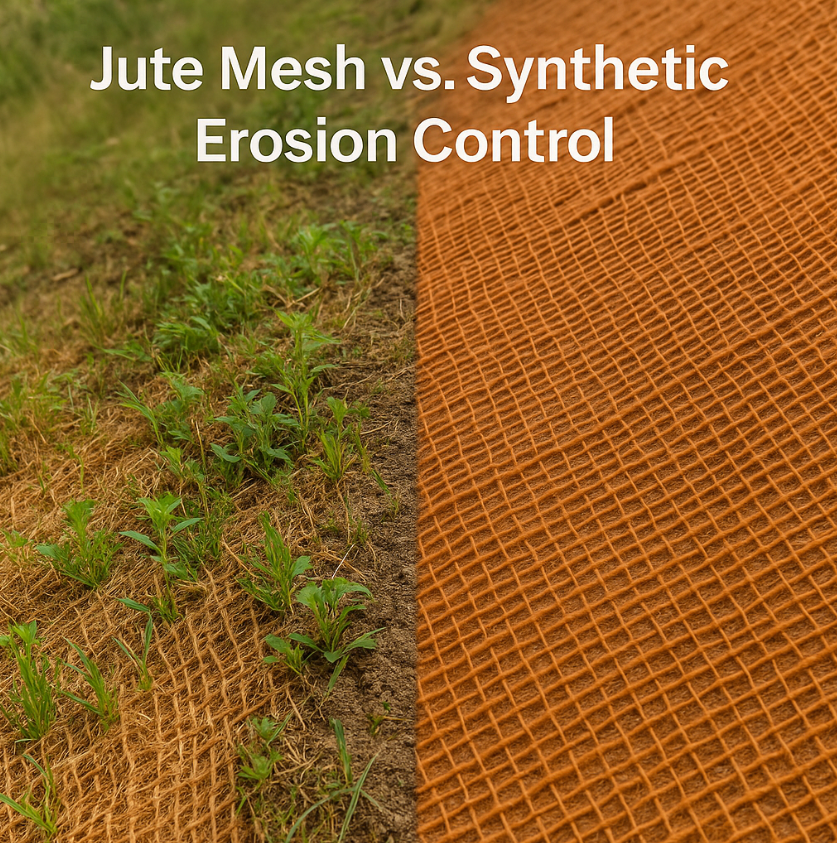- July 4, 2025
- Posted by: wellcoindustries
- Categories: Erosion Control, Jute Mesh
Introduction
Erosion-control blankets are not one-size-fits-all. On today’s jobsites, specifiers must weigh long-term durability against carbon targets, disposal fees, and emerging “plastic-free” procurement rules. Natural jute mesh erosion control blankets compete directly with synthetic polypropylene (PP) and high-density polyethylene (HDPE) mats—and both camps have proven winners. Drawing on field data (including a 2025 Syracuse University rainsplash study) and nearly two decades of project experience, this guide shows where each product shines and how to choose confidently. As a vertically integrated manufacturer, Wellco Industries supplies both woven jute and synthetic blankets, giving buyers unbiased insight and single-source traceability.

The Fundamentals of Jute Mesh Erosion Control
What Is Jute Mesh?
Woven from bast fibers of the jute plant, the blanket forms an open lattice (≈11 × 4 mm) that pins seed and topsoil until vegetation locks everything in place.
Natural Performance Benefits & Limitations
Field note (first-person): “On a 2 H:1 V railway cut in Penang last March, our crew swapped plastic netting for jute after seedlings scorched in 40 °C sun. We staked 400 m² before lunch; by week three, vetiver roots had already laced through the weave, and runoff channels disappeared,” recalls Yu Wei, Wellco’s Malaysian site trainer.
Pros
-
Biodegrades in 6–24 months, adding organic matter.
-
Dampens soil temperature and glare—friendlier to germinating seed and passing traffic.
-
Works with biodegradable stakes; no end-of-life haul-off.
Cons
-
Tensile strength (~1.5 kN m⁻¹) below UV-stabilised PP.
-
Faster decay in acidic or high-rainfall soils.
The Fundamentals of Synthetic Erosion-Control Mats
Common Synthetic Materials
-
Polypropylene (PP) – UV-stabilised blankets, 5–10 year design life.
-
HDPE – tough fibres for high-flow channels.
-
Polylactic acid (PLA) – bio-based but still behaves like plastic in landfills.
Strengths, Drawbacks, and Typical Use Cases
ASTM D6818 tensile tests from 2024 showed PP blankets retaining 3.8 kN m⁻¹ after 500 h UV—more than double jute’s starting strength. Synthetics excel where:
-
Design life >5 years or shear stress >5 Pa.
-
Repeated wet–dry cycles threaten natural fibres.
But they leave micro-plastic fragments and incur disposal fees.
Head-to-Head Comparison: Jute Mesh vs Synthetics
Soil Retention & Vegetation Establishment
A 60-day Texas A&M slope trial recorded 92 % soil retention and 85 % vegetative cover for jute, versus 94 % and 76 % for PP—natural fibres let shoots penetrate faster.
Durability & Lifespan Under Varying Climates
Case study: In Ontario, jute protected lower slopes (≤20 °) while PP guarded the crest. After two freeze–thaw winters, PP remained intact; jute had fully biodegraded yet left stable turf. Total project cost came in 14 % under the rock-riprap alternative.
Environmental Impact & End-of-Life Scenarios
Dr Leila Howard of the Soil Conservation Society notes that biobased blankets “fit low-carbon specs and avoid the cleanup clauses many DOTs now include for plastics.”
Total Cost of Ownership & Supply-Chain Factors
Up-front, jute blankets average US$1.00–1.40 m⁻²; UV PP runs US$1.25–1.80 m⁻². When you add landfill charges and CO₂ reporting, jute can be 25 % cheaper over its life. Wellco’s ISO 9001 & 14001–certified campus weaves both textiles and can private-label to spec—download certificates and ASTM sheets from the Wellco resource hub.
Installation & Maintenance Best Practices
Site Assessment & Prep Checklist
-
Soil pH & texture—acidic soils accelerate jute decay.
-
Slope length & gradient—breaker trenches every 7 m on >3:1 slopes.
-
Hydraulic flow—channels over 4 Pa may need reinforced synthetics (TRMs).
Step-by-Step Installation: Jute vs Synthetic
| Step | Jute Mesh | Synthetic Mat |
|---|---|---|
| Anchor trench | 200 mm deep | 150 mm deep |
| Overlap | 150 mm | 100 mm |
| Fasteners | 30 cm O.C. bio-pegs | 50 cm O.C. steel pins |
| Seeding | Before blanket | Before or after |
Monitoring, Maintenance & Troubleshooting
Inspect after the first 25 mm rain. If jute edges lift, add pegs; if PP ponds, vent with an awl and reseed bare spots—advice from the Wellco field team.
Safety & Environmental Compliance
-
PPE: gloves (jute fibres can splinter), safety glasses during trenching.
-
Disposal: jute can be tilled into soil; PP offcuts go to licensed recyclers.
-
Micro-plastics: use drip-edge barriers when cutting PP near waterways.
Guidelines align with USDA-NRCS “After the Fire” ECB spec and FAO slope-stabilisation notes. nrcs.usda.govfao.org
Decision Framework: Choosing the Right Solution
Project-Specific Criteria
-
Hydraulic energy—synthetics resist >5 Pa shear.
-
Sustainability goals—parks, wetlands and LEED projects favour naturals.
-
Budget horizon—include end-of-life removal for plastics.
Supplier Due-Diligence & Certificates
Request ISO certificates, ASTM test data and MSDS sheets. Wellco controls spinning, weaving and coating under one roof—one PO, full traceability.
Conclusion
Natural jute blankets excel at quick revegetation and low-carbon specs; synthetics dominate in extreme hydraulics and multi-year designs. A data-driven choice lets contractors meet performance targets and new environmental mandates. Need sample rolls or OEM packaging? Contact Wellco Industries—our engineers answer within 24 hours.
Frequently Asked Questions
-
How long does jute mesh last on the slope?
In temperate climates jute typically biodegrades within 6–12 months, giving seedlings time to anchor before disappearing. -
Can I combine jute and synthetic blankets on one project?
Yes—many contractors use jute on lower, gentler slopes and PP at crests or high-flow channels to balance cost and durability. -
Does jute meet DOT or NRCS specs?
Open-weave 500–700 g m⁻² jute blankets appear in multiple NRCS practice standards and many state DOT qualified-product lists. -
What stakes should I use with jute?
Biodegradable hardwood or PLA stakes every 0.3 m on centre; metal pins can remain but defeat an all-natural spec. -
Can Wellco private-label erosion blankets?
Absolutely—our integrated mill can add custom logos, roll lengths and pallet branding with MOQs as low as 2,000 m².
